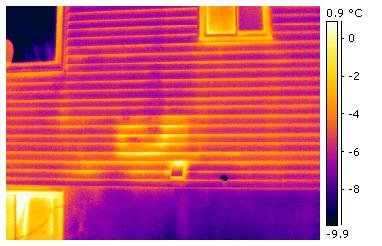Before we can look at ways to quantify our heat losses, I think we should look at how building dynamics affect the way we look at those heat losses. First I will introduce a diagram to help with the explanation.
For all of us this is intuitive. (1)When we open a door or window on a wall facing the wind, the wind will blow into the house.(2) Conversely, when we open the same door or window which faces away from the wind, the warm air blows out the door.
Since the wind blows into the building on the windward side, the same will be true of any leaks in the building envelope on that side of the building. When we look for heating losses on this side of the building they will be seen on the interior wall of the building and will be colder than the interior temperature (or on the exterior wall on the leeward side in summer when the building is air conditioned). In the second case, because the interior pressure is highest on the leeward interior wall and the pressure is the least on the outside wall, we will look for warm spots on the exterior side of the building (or on the interior side of the windward wall in summer when air conditioned). On the sides of the building that see increasing pressures there will be evidence of envelope impingements on both side depending on the interior pressure gradient.
It is important to use the pressure dynamics of the building to discover the best way to use thermal imaging to its advantage. However air is a funny thing. Often losses can be detected on both the outside and inside depending on wind direction and speed. When scanning a building, use your camera all the time and you might find air impingements in spots they are not expected. These breaches may be seen on different floors as cold air might fall down the inside of the envelope.
This small fault (above and to the left of the vent) appears to be along the first floor baseboard. However it was caused by missing insulation from the installation of plumbing for a basement bathroom and this fault was evidenced in the bathroom. The heat losses rose up the interior and are seen above the basement level.
Evidnce of the fault is clearly visible in the new basement bathroom. Cold air is falling down the inside wall to the basement level.
Remember one more thing. Any place where we see cold air on an inside wall or warm air on an outside wall, introduces the possibility of mold growth in the area of the heat exchange. With today's tight envelope homes, this can be a real health problem!
The next entry will look at templates that I have developed to measure the power lost (in watts per square meter) of envelope problems.




No comments:
Post a Comment